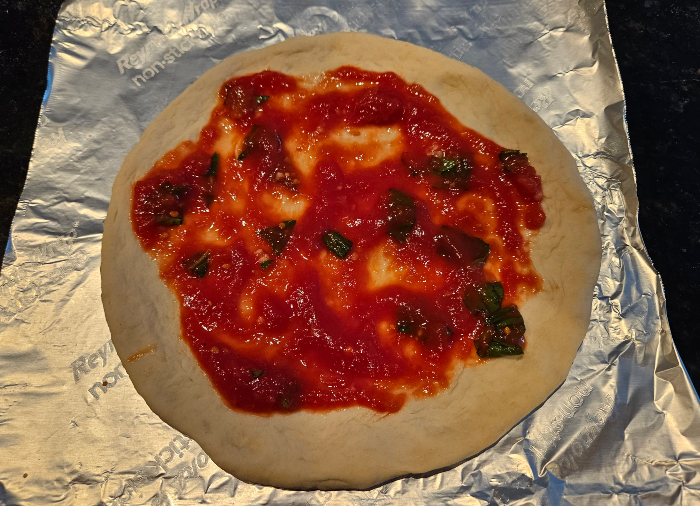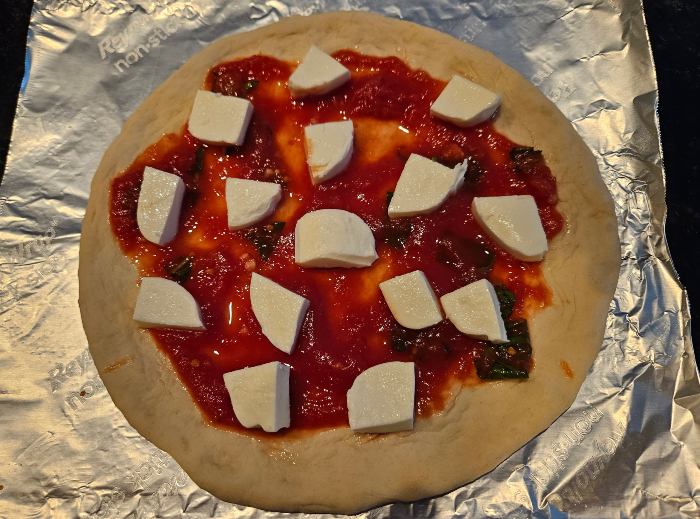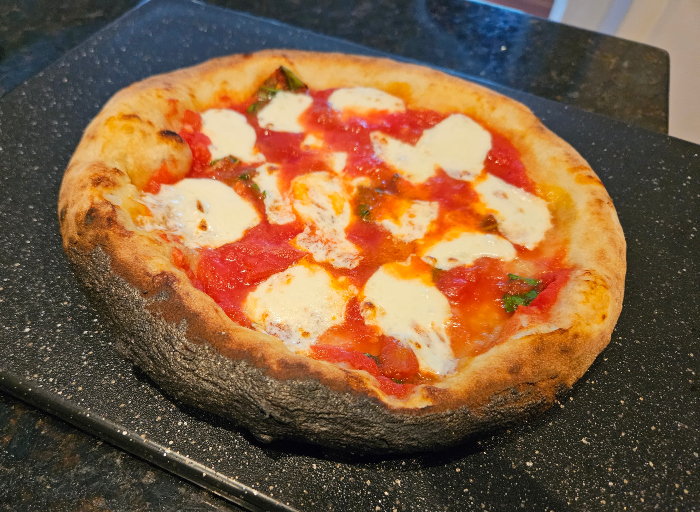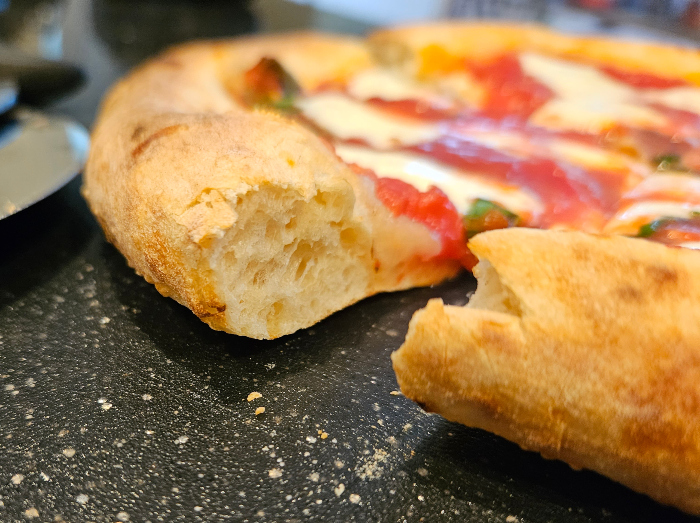First Neapolitan Pizza
July 11th, 2023Enthusiasm Outpaces Skill
Yesterday I fired up the new Walmart pizza oven and made a Neapolitan-style pie. I am here with the results.
After reading about Neapolitan pizza and consulting experienced people, I decided to use these dough ingredients:
INGREDIENTS
100 grams Primo Gusto high-gluten flour
60 grams water
0.75 teaspoons salt (supposedly 3 grams)
1/8 teaspoon yeast
When you bake like an intelligent person, you weigh everything carefully, and you list the weight of each ingredient as a percentage of the weight of the flour. I was told that Neapolitan pizza requires a dry dough with 60% hydration, meaning the water should weigh 60% as much as the flour. The ideal salt percentage is said to be 2.5-3%, which is common to a lot of breads. I use measuring spoons for yeast because I’m not going to sit around weighing tiny amounts of leavening. It’s not critical.
I usually go with 67% hydration, a small amount of sugar, and a little oil (except for Sicilian), so the dough I made for Neapolitan was pretty stiff.
Unfortunately, the grams-to-teaspoons conversion I used for salt appears to have been wrong, so I may have used about 50% more salt than I should have. Salt slows fermentation, and too much salt ruins the flavor of bread.
I let the dough rise for two hours at room temperature, and then I refrigerated it. Early the next day, I set it out to ferment at room temperature again. I got these instructions from the web.
When the oven was hot, I didn’t have a lot of time to wait for the dough. Late in the afternoon, I took it out to shape it, and although it had doubled in size, it was awfully hard compared to my usual dough. I stretched it anyway.
I made a small pie because I don’t have a peel the right size for this oven. It’s on the way. I have a peel 9″ wide, so I sized the pie to fit it.
For sauce, I pureed Cento San Marzano peeled tomatoes. They were really sour. They say you shouldn’t put anything but salt in Neapolitan sauce, but I was the one who had to eat it, so I left the salt out and added a little sugar and pressed garlic.
Pizza without garlic is a missed opportunity.
I also mixed a little fresh basil into the sauce. A lot of people dump fresh basil on finished pies or bake it on top of the sauce and cheese. Those people are nuts. Fresh basil is not tasty at all, and baking it on top of everything can burn it. I think they do it for the sake of appearance.
A destructive obsession with presentation is one of the hallmarks of bad cooks. The world is full of bad cooks, including cooks with degrees, who proudly present beautiful bad food, thinking they’ve done something wonderful.
For cheese, I tore up about 2 ounces of Belgioioso fresh mozzarella and dumped them on the sauce.
I did something I should not have done. I decided to try my usual method of loading the oven. Most people put corn meal or semolina on their peels to make raw pizzas slide off. I don’t, because it’s a dumb thing to do. It makes a mess, and often, it doesn’t work. I put a sheet of nonstick foil on my peel. I slide the foil and pizza onto my steel, and two minutes later, I pull the foil out. Works great for New York style pies.
Looks like it does not work for Neapolitan, however.
I put the pie in the oven, gave the hot stone some time to dry up the underside of the crust, and tried to pull the foil out. It hung on something, and when it came out, it had a little hole in it. I don’t know if it stuck to the pie or what.
Neapolitan pies in cheap ovens cook quickly on one side, so you have to turn them. When I tried to turn the pie, it resisted. Turned out there was a tiny hole in it, and sauce had gone through and hit the stone, gluing the pie down in one spot. I broke it free, but by the time I got it moving, one side of the pie was black.
When I took the pie out, it had problems.
The dough was underfermented, which is one reason it was hard. This prevented it from blowing up properly, so the pizza was somewhat heavy. It also tasted salty. Finally, the bottom was undercooked. It should have been partially charred. I think the foil did me in. I’ll post pictures.
I think this oven will make good pizza if I get things right. Today I’m making another pie, fermented overnight at room temperature. It should be much poofier. I’m also going to use the hated corn meal.
I don’t know if I’ll be able to make big pies, because the heat is so intense near the back of the oven. The bigger a pie is, the closer the rim will be to the heat.
The sauce was surprisingly good. I make a more flavorful sauce for New York pies, and I’m sure it would be better than yesterday’s sauce on Neapolitan pizza, but it was okay.
The cheese was also surprising. If you put fresh whole milk mozzarella on a New York pie, it shrinks and shoots water and grease onto the pizza. In yesterday’s pie, it just melted and spread out. No problems at all.
Will I continue and then move on to an expensive gas oven? Can’t say, but so far, the results are encouraging.




July 12th, 2023 at 6:21 PM
We all know the answer to that question. I enjoy your experiments though I’m allergic to almost everything on a pizza.
July 13th, 2023 at 6:58 AM
Experimenting is some of the most fun in cooking, second to that moment you get it perfect, and perfectly reproducible.
Then it gets boring, churning out perfection whenever you want. And you have to start experimenting again with something.